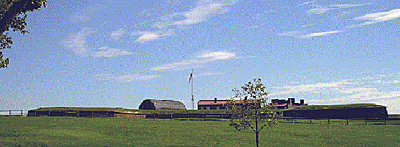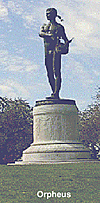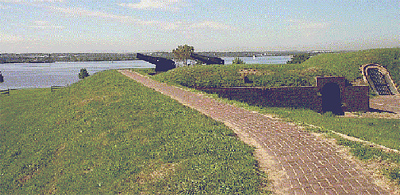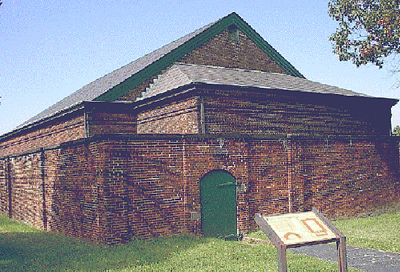 Old forts present a recurring historic theme in the eastern United States. Some of the best-preserved and most intriguing are found in the region, such as Old Fort Niagara in Youngstown, New York, and Fort Moultrie, on the harbor of Charleston, South Carolina. Sometimes the heavy and obvious wear and tear suffered by some structures is testimony to what makes them special; witness the nearly ruined Fort. Sumter.
Old forts present a recurring historic theme in the eastern United States. Some of the best-preserved and most intriguing are found in the region, such as Old Fort Niagara in Youngstown, New York, and Fort Moultrie, on the harbor of Charleston, South Carolina. Sometimes the heavy and obvious wear and tear suffered by some structures is testimony to what makes them special; witness the nearly ruined Fort. Sumter.
Fort McHenry is a rare treasure in that it combines both an excellent state of preservation and an emotional place in American history rivaled only by Sumter. The current structure dates back to the Washington administration, when Secretary of War James McHenry commissioned a fort for Baltimore Harbor, replacing a Revolutionary-War era work on the same site called Fort Whetstone. It had a long and largely uneventful tenure as a military base, prison and hospital through World War I.
 George Armistead, commander of the fort during the bombardment.
George Armistead, commander of the fort during the bombardment.
That is, uneventful but for one night in 1814. In September of that year a Royal Navy fleet bombarded the fort for twenty-five hours in a vain attempt to capture Baltimore. It failed. But watching from the deck of a British warship was Francis Scott Key, an attorney who had approached the British to secure the release of a client arrested for spying on the same army that had burned Washington. Key won his freedom, but for security reasons the British insisted that he remain with the fleet until the battle for Baltimore was decided.
What Key saw from the deck of an enemy warship he immortalized into a poem. Ironically to say the least, when it was set to the music of a British army drinking song, it became the National Anthem.
The defense of Fort McHenry did become a potent national image. But more important to the national psyche than the repulse of the British was Key’s witness of it, and the enormous battle flag that waved over the fort in defiance. Presaging Marshall McLuhan by a century and a half, the poetic medium became the message, in some ways eclipsing the battle.
Fort McHenry Today
Fort McHenry National Monument and Historic Shrine owes its existence to “The Star Spangled Banner,” both the song and the flag, and immortalized. Were it not for these twin images, not only is it doubtful that the site would have been preserved as a national treasure, the only one in the National Park Service to be designated a shrine, but questionable as well that the fort would have survived at all.
 Orpheus
Orpheus
The fort sits between the busy harbor and a neighborhood; the margin between preservation and demolition in favor of housing or industry is not a wide one. One’s first sight of Fort McHenry is of a long, red brick wall separating the grounds from adjoining city, and access is through a gate that is barely wide enough to handle traffic going both ways. On the other side is another sign that the site dates to a time in which history could be used to reach for the universal instead of hammered by self-consciousness or exploited for passing ideological fads. There is a large statue of a naked Orpheus, the Greek patron of music, happily playing his lyre. Local legend stated for many years that Orpheus was really a representation of Francis Scott Key, but the statue was erected instead to honor the genius of music and Key’s inspiration rather than to memorialize the man himself.
There is a second statue near the fort itself, a monument to George Armistead, the commander of Fort McHenry during the bombardment. Fort McHenry proper is situated in the midst of what resembles a city park more than anything. From an engineering standpoint, it is a standard five-bastioned, brick-faced earthen fort of a type built from the seventeenth to the mid-nineteenth century. It is hardly the biggest in America, with a surprisingly small central parade ground. In 1814, the fort was fronted on the sides toward Baltimore Harbor and Chesapeake Bay with water batteries, but these are long gone.
 Inside the shell of the “star fort,” the buildings and powder magazine around the parade ground all date from periods after the War of 1812, but are full of exhibits commemorating the events then. As one might expect, there are the usual reconstructions of barracks rooms and officers’ quarters, and relation of human interest anecdotes, such as how hot coffee was carried to the fort every morning in barrels with carpets wrapped around them. However, a greater sophistication sneaks in unheralded, with a lot of information on the specific units garrisoning Fort McHenry.
Inside the shell of the “star fort,” the buildings and powder magazine around the parade ground all date from periods after the War of 1812, but are full of exhibits commemorating the events then. As one might expect, there are the usual reconstructions of barracks rooms and officers’ quarters, and relation of human interest anecdotes, such as how hot coffee was carried to the fort every morning in barrels with carpets wrapped around them. However, a greater sophistication sneaks in unheralded, with a lot of information on the specific units garrisoning Fort McHenry.
Yet there is also a major emphasis of the fort is on the Civil War, when the fort served more as a military prison than as a guardian of Baltimore and its port. In fact, the most conspicuous of the cannons there are mid-century Rodman coastal defense guns mounted along the ramparts; by contrast, the greatest concentration of earlier weapons from the French Revolution and Napoleonic era appear to be dumped, without carriages, between a couple of barracks. Such weapons called for greater stores of ammunition than could be accommodated in the central magazine, itself larger than the one used in the War of 1812, and so there is a larger one dating to the Civil War outside the walls.
 At the same time, the appeal of Fort McHenry goes far beyond its architectural value, or any insights it can impart. Just as Little Round Top is more than a hill with a rocky slope on one side and Bloody Lane is more than a ditch, the importance and the appeal of Fort McHenry extends beyond such terms, and for that reason it is a mandatory destination for any historically-minded American passing through Baltimore.
At the same time, the appeal of Fort McHenry goes far beyond its architectural value, or any insights it can impart. Just as Little Round Top is more than a hill with a rocky slope on one side and Bloody Lane is more than a ditch, the importance and the appeal of Fort McHenry extends beyond such terms, and for that reason it is a mandatory destination for any historically-minded American passing through Baltimore.
GETTING THERE
For travelers coming in from outside Baltimore, Maryland, Fort McHenry is easily reached from Interstate 95; take Exit 55 (Key Highway), and follow Key Highway to Lawrence Street. Turn left onto Lawrence, then take another left at Fort Avenue. The Fort is at the end of Fort Ave., about one mile from Lawrence. From the Inner Harbor, take Light Street south to Lawrence, and follow Lawrence and Fort.
Back to Cry Havoc! #41 Table of Contents
Back to Cry Havoc! List of Issues
Back to MagWeb Master Magazine List
© Copyright 2003 by David W. Tschanz.
This article appears in MagWeb.com (Magazine Web) on the Internet World Wide Web. Other articles from military history and related magazines are available at http://www.magweb.com